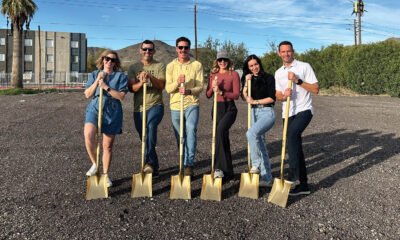Entertainment
Colorado River States Grapple with Water Cuts and Long-Term Solutions

WASHINGTON (AP) — The federal government is poised to announce significant water cuts, impacting approximately 40 million people who rely on the Colorado River, a critical resource for the U.S. West. The Interior Department traditionally sets water availability for the coming year well in advance, enabling Western municipalities, farmers, and industries to plan accordingly.
However, ongoing discussions are underway about how water from the dwindling 1,450-mile (2,334-kilometer) river will be allocated after 2026, when many existing guidelines will lapse. This river provides water to seven states, numerous Native American tribes, and two Mexican states, while also supporting agriculture and hydropower across the region.
The prolonged drought and overuse have resulted in reduced water flow in the Colorado River, prompting states to reconsider their water-sharing agreements. Current discussions revolve around distributing the river’s resources more equitably, especially as agreements, court rulings, and contracts expire at the end of 2025.
In 2007, after severe drought conditions, the basin states—Arizona, Nevada, California, Colorado, New Mexico, Utah, and Wyoming—collaborated with the federal government to create more robust rules addressing diminishing water levels in Lake Mead and Lake Powell, the river’s main reservoirs. These regulations dictate when certain states face water reductions based on reservoir levels, which drives the urgency for new planning in response to projections indicating more substantial cuts after 2026.
Jack Schmidt, a professor at Utah State University and director of the Center for Colorado River Studies, stated, “The ultimate problem is that watershed runoff is decreasing due to an ever-warming climate.” He urged for a reduction in overall water usage in light of these alarming trends.
In a forthcoming announcement, the federal government is expected to unveil water cuts for 2025, potentially maintaining current restrictions. Evaluations of precipitation, runoff, and consumption inform these decisions, with particular focus on Lake Mead’s levels. While states like California benefit from senior water rights, those reliant on this resource face looming uncertainties.
The Upper Basin states—Colorado, New Mexico, Utah, and Wyoming—have not fully utilized their allocation from the river, receiving a share of available water each year. An acre-foot of water typically supplies two to three households annually.
In terms of conservation efforts, recent rainfall and strategic water-use initiatives have improved the immediate situation for reservoirs. Lake Powell currently stands at roughly 39% capacity, while Lake Mead sits around 33%. Nevertheless, climate experts warn that rising temperatures will exacerbate future water shortages and evaporation issues, indicating that ongoing preparations are essential.
Disagreements persist among states regarding the management strategy for the Colorado River. Arizona, California, and Nevada advocate for a more inclusive approach that considers water levels across all seven reservoirs, aiming for equitable distribution of deeper cuts among users. Meanwhile, Colorado, New Mexico, Utah, and Wyoming favor a policy framework that addresses shortages based on combined reservoir capacity, proposing more urgent cuts for the Lower Basin states.
As negotiations continue, the federal government anticipates releasing draft regulations in December, incorporating various proposals to forge a path forward. Stakeholders, including states and tribes, remain engaged in discussions aimed at achieving consensus on water management strategies moving into an uncertain climate future.
Copyright 2024 The Associated Press. All rights reserved. This material may not be published, broadcast, rewritten or redistributed without permission.

















